A
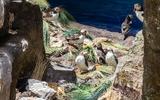
Atlantic puffin
Fratercula arctica
Conservation status
Vulnerable
Fresh, salted or smoked: in the past, Atlantic puffins were widely eaten as a delicacy. Today, these birds are generally a protected species, and their breeding cliffs are tourist attractions. Even so, since 2015, the Atlantic puffin has been classified as vulnerable. Many colonies are declining, not because the birds are being hunted for food, but more likely as a result of significant changes in the seas. Atlantic puffins feed mainly on small fish such as sand eels, whose stocks — like those of countless other marine creatures — are threatened by climate change and overfishing.
B

Common murre
Uria aalge
Conservation status
Least concern
Each year, murre breeding colonies are the scene of an impressive natural spectacle: around three weeks after hatching, thousands of murre chicks leap simultaneously from their nests on narrow cliff ledges. Not yet able to fly, they use their half-grown wings to glide down from a great height into the sea. Most will survive even a hard landing in the sand, cushioned by a thick layer of fat. The chicks — already able to swim — are then escorted out to sea, where they are fed by the male parent for another few weeks.
C
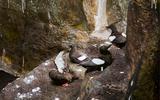
Black guillemot
Cepphus grylle
Conservation status
Least concern
D
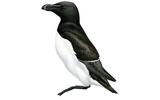
Razorbill
Alca torda
Conservation status
Least concern
E
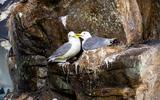
Black-legged kittiwake
Rissa tridactyla
Conservation status
Vulnerable
F
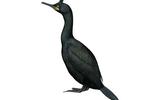
European shag
Gulosus aristotelis
Conservation status
Least concern
G
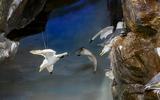
Herring gull
Larus argentatus
Conservation status
Near threatened